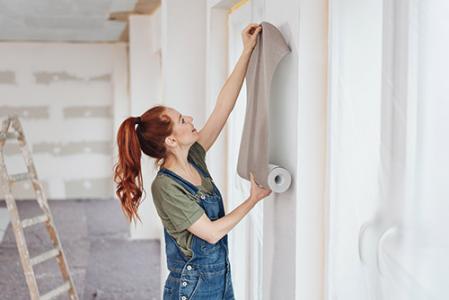
Peel-and-Stick vs. Traditional Wallpaper: Which is Right for Your DIY Project?
Are you thinking of giving your home a fresh, stylish look? Wallpaper can transform your space, adding color, texture, and personality. And there are hundreds of patterns to choose from!
However, before scrolling through pages of wallpaper options, it’s best to decide which TYPE of wallpaper you’ll want to use: traditional or peel-and-stick.
We'll break down the pros and cons of each, from installation to removal and everything in between. So, let's dive in and find the perfect fit for your DIY decorating project.
1. Product Basics: What’s the Difference?
Peel-and-Stick Wallpaper:
Peel-and-stick wallpaper, also called removable wallpaper, has exploded in popularity. Since it’s easier to remove, peel-and-stick wallpaper is often marketed as a perfect solution for homeowners (and renters) who don’t want to make long-term decorating commitments.
Traditional Wallpaper:
With an extensive and proven track record, traditional wallpaper boasts the most options, including textured patterns, bold botanicals, metallics, geometrics, abstracts, and florals (although peel-and-stick designs are catching up!). Traditional wallpaper comes in two versions: pre-pasted (add water to activate the glue) or non-pasted.
2. Installation: DIY-Friendly or a Headache?
Peel-and-Stick Wallpaper:
Installing peel-and-stick wallpaper is usually beginner-friendly and always mess-free. No prior experience is required, and there's no need for paste or water. If you make a mistake, you can lift and reposition the wallpaper. However, you won’t be able to make minor adjustments by sliding the paper on the wall as you can with wet, traditional wallpaper.
Traditional Wallpaper:
Traditional wallpaper installation is time-tested and produces durable, long-lasting results. But it can be messy, requires paste application that might be challenging for beginners, and may necessitate skilled labor.
3. Cost: The Price of a Beautiful Space
Prices vary substantially among traditional and peel-and-stick wallpapers, depending on the material used. Generally, vinyl wallpaper is the most budget-friendly option, while paper, fabric, grasscloth, and other materials tend to cost more per square foot.
Of course, if you hire a professional to install your wallpaper, you must also factor this expense into your budget.
4. Tools: What's in Your DIY Arsenal?
Peel-and-Stick Wallpaper:
When working with peel-and-stick wallpaper, you'll need a utility knife or scissors, a tape measure, a straightedge, a smoothing tool (such as a plastic squeegee or a credit card), and a ladder or step stool for high places.
Traditional Wallpaper:
You’ll need all the same tools to install traditional wallpaper, plus paste or adhesive, a wallpaper brush or roller, a seam roller, and a level for precise application.
5. Wall Prep: First Things First!
Peel-and-Stick Wallpaper:
Peel-and-stick wallpapers adhere best to smooth, hard surfaces. That means you’ll get better application results if you repaint any matte or flat-finish walls with an eggshell or semi-gloss paint—and allow time for the paint to harden and cure before applying the wallpaper.
Traditional Wallpaper:
Before installing traditional wallpaper, you’ll also need to prep the walls. Apply a primer designed to “size” the walls. A wallpaper primer will help the paper adhere better and will make it much easier to remove the paper later.
6. Removal: The End of an Era
Peel-and-Stick Wallpaper:
Peel-and-stick wallpaper is simple to remove, and if you’ve prepped your walls properly, it should lift without damaging them. It leaves little to no adhesive residue, but it's not reusable and must be discarded after removal.
Traditional Wallpaper:
Traditional wallpaper can be time-consuming to remove, and adhesive residue can be challenging to clean. The removal process involves saturating the surface and slowly peeling back (or scraping off) the sheet as the glue softens.
7. Pattern Matters: Finding the Right Look
Peel-and-Stick Wallpaper:
Peel-and-stick wallpaper works well with various patterns, but solid colors and small prints are more forgiving for beginners.
Traditional Wallpaper:
Traditional wallpaper is ideal for intricate or large patterns since it’s easier to make slight positioning adjustments that allow precise alignment.
Other Considerations and Tips
It’s always advisable to follow these suggestions regardless of whether you choose peel-and-stick or traditional wallpaper:
- Ensure your walls are smooth and free of imperfections. Use sandpaper to remove any bumps, and fill any dents with a spackling compound.
- When purchasing wallpaper, order more than you think you'll need to account for mistakes and repairs.
- Pay attention to pattern alignment, especially when working with intricate designs.
Ultimately, choosing between peel-and-stick and traditional wallpaper depends on your preferences and budget. Peel-and-stick is perfect for beginners or those seeking a quick, cost-effective update, while traditional wallpaper offers a broader array of design possibilities and long-lasting beauty.
Whatever you decide, your wallpaper choice will not only transform your living space but also reflect your personality and style. Happy decorating!
